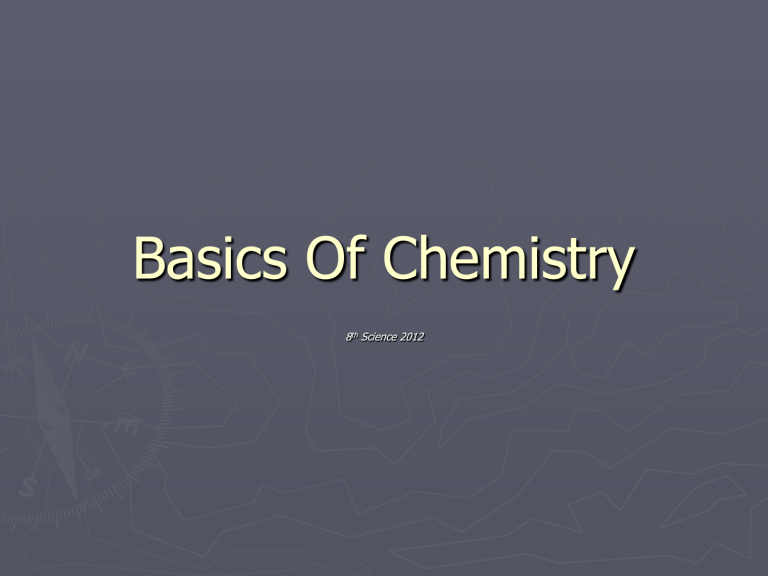Basics Of Chemistry

Basics Of Chemistry
8 th Science 2012
Matter Defined
►
Matter – anything that has volume or mass.
►
Everything you see and don’t see.
Definitions
►
Element- pure substance that cannot be separated into simpler substances by physical or chemical means.
Represented by a symbol – Au stands for what?
Definitions
►
Atom – Smallest particle into which an element can be divided and still be the same substance, retaining its properties
Evolution of the Atomic Theory
►
►
►
►
Democritis – 440 BC
Greek philosopher who said that if you cut a substance in half again and again and again eventually you would have an “uncuttable” piece said that all atoms made of a single material formed into different shapes and they join together to make different materials
Greek word atomos
“indivisible”
, which means
John Dalton - 1803
►
Studied the atmosphere and other gases and developed atomic theory.
►
Dalton demonstrated that elements combine in specific
proportions to make different substances
John Dalton’s Atomic Theory
►
1. All substances are made of atoms .
Dalton’s New System of Chemical Philosophy
►
2. Atoms are small particles that cannot be created, divided, or destroyed.
Dalton’s Atomic Theory, continued
►
►
►
3. Atoms of the same element are identical in size, mass and other properties.
4. Atoms of different elements combine to make chemical compounds.
5. In chemical reactions , atoms are combined, separated, or rearranged.
J.J. Thomson - 1897
► discovered that there are small particles inside the atom, so the atom can be divided into smaller parts
JJ Thomson, continued
►
Experimented, using a cathode-ray tube to discover negative
particles he called corpuscles
► these negatively charged particles found in all atoms are now called electrons
Thomson’s Model
►
Plum Pudding model
►
Described electrons as scattered all about the atom
Ernest Rutherford - 1908
Rutherford, continued
►
Discovered a tiny, extremely dense, positively charged region called a nucleus
►
Most of the atom’s
mass was in the nucleus and electrons traveled around the nucleus
Rutherford cont’d
► said the atom was mostly
empty space
Niels Bohr – 1913
► said the electrons
travel around the nucleus in definite paths
Erwin Schrödinger and
Werner Heisenberg - 1926
►
Said electrons travel in clouds, not definite paths but we still use the Bohr Model to represent atoms.
The Atom
Subatomic Particles
Protons
►
►
►
Determine the identity of the matter
positively charged particles found in the nucleus
Mass =1.67262158 × 10 -27 kilograms
0.000000000000000000000000017 kg
►
Each proton is 1 amu
AMU stands for Atomic Mass Unit
Subatomic Particles
Neutrons
Neutrons are the glue that holds the protons together in the nucleus
►
►
► no charge found in the nucleus mass is 1 amu
Subatomic Particles
Electrons
Determine the reactivity
►
Negatively charged
►
►
Found around the nucleus within electron clouds
Mass is very small, almost zero
Atoms are NEUTRAL
►
Atoms are neutral because the number of protons equals the number of electrons.
►
►
►
►
How To Read a Square
8
O
Oxygen
15.9994
►
Elements are identified by their atomic number – the number of protons. Also equals the number of electrons.
►
Chemical Symbol
►
Element Name
►
Atomic Mass
PEN Method
►
SLIDE, SLIDE, ROUND
THE BOTTOM
SUBTRACT TOP
►
P = 8
►
E = 8
►
N = 8
►
►
►
►
8
O
Oxygen
15.9994





